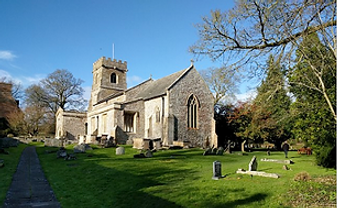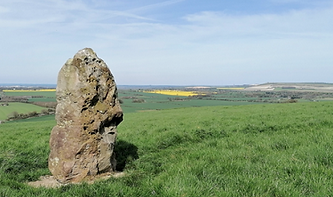

Full-day country walks in
SE England and beyond
Ogbourne St George to Avebury
Distance: 11 miles.
Time without long breaks: 6 hours.
Terrain: Pretty easy-going, although a few small climbs.
How to get there and back: Catch a train to Swindon, then walk to the main bus station (5 mins). From here, get an X5 or 80 bus to Ogbourne St George (alight at the Downs Golf Club stop on the X5 or Liddiards Green on the 80). Return to Swindon via the 49 bus from Avebury. Buses are quite frequent but check Traveline for times.
Pub breaks: There are no pubs apart from the end of the walk, where the Red Lion at Avebury is conveniently situated next to the bus stop.
More information: Allow extra time if you want to fully explore Avebury and the nearby neolithic monuments (also see walk 51).
Click on the image below to access the full map on plotaroute

Mostly following the ancient Ridgeway path (see panel on walk 9), this route starts at the village of Ogbourne St George in Wiltshire and runs along Smeath's Ridge through the beautiful undulating landscape of the Marlborough Downs. It includes Barbury Castle, a hill fort and the site of a dark ages battle, and the Hackpen White Horse. Passing a cluster of burial mounds, it concludes at the World Heritage Site of Avebury and its famous stone circles, which surround the village.
If alighting from the X5 at the golf club, walk in the same direction as the bus, taking the left-hand fork down the lane that runs parallel to the main road. When you reach the crossroads, turn right and go under the road bridge to reach Ogbourne St George. Immediately after the bridge, take the right fork into Bottom Lane. When you reach the junction by what used to be a pub, turn right and go down the High Street to the centre of the village. You pass Liddiards Green on the right. This is where you alight if you have caught the 80 (head back in the direction the bus came from). On the right, just after the road crosses over the River Og, is the lane to the 12th-century church of St George.

You eventually reach a signpost by some horse rails, Ahead you will see some wooden gates. Go through these and turn right down the lane. In 200m, opposite the entrance to Upper Herdswick Farm, go through the metal gate on your left to enter Barbury Castle Country Park. Alternatively, you can take a short diversion here: Carry on down the lane, passing the entrance to a car park on your left, and take a right through a metal gate next to a farm gate that leads into a field. A short distance along, to the left of the path, you will see a sarsen stone which is a memorial to the poet Alfred Williams and the transcendental nature writer Richard Jefferies (see panel below). Return back the way you came.

Exit the fort on the opposite side to where you came in via the gap in the banks. There is a large burial mound on your right. Continue down the chalk path and go through the gate to the lane. Turn right and then in a short distance turn left along the byway, following the Ridgeway. Ignore another byway that comes off on your right and keep straight ahead. You will soon come to the first of three plantations of beech trees next to a footpath sign. Just under half a mile from the final plantation, you will come to a car park and a road. On the other side is an information board. Take a right through the swing gate to reach the Hackpen White Horse.

Turn right here through a small gate, following the bridleway. Descend downhill across Monkton Down. You emerge at a farm lane, the driveway to New Barn (when we did this walk, there were some beautiful white long-horned cattle in the adjacent field). Head down the lane to a metal gate, then turn left past the buildings to emerge at a field. You pass a well on your left and some stones (the remains of a burial chamber) on your right. When you enter the following field you will see some trees ahead of you. There is a small cluster of round barrows here. Follow the path around as it runs along the southern edge of the trees and then head straight down to reach a chalk track called Herepath.


Keep on going down the High Street, following the bends in the road. You pass the entrance to the Manor House on the right. After 250m, the lane turns sharp right and 100m further on you will see a five-fingered post on your right. Turn left down the track to join the Ridgeway long-distance footpath. When a path forks off to the right, carry on straight ahead along the public byway via the farm gate. The path proceeds through the pasture land below Coombe Down, running parallel to a fence. It then continues along Smeathe's Ridge, going through a metal gate and past horse gallops with panoramic views of the Marlborough Downs.

The path joins a lane that runs past a car park. Head for the wooden gate straight ahead by the toilet block and then proceed via a metal gate, still on the Ridgeway. Go through another gate to reach Barbury Castle iron age fort, which was first occupied around 2,500 years ago. Archaeologists have discovered signs that around 40 huts were once built on the site (there used to be a replica iron age hut here, but it was destroyed in a fire). The fort was later occupied by the Romans. It was also the scene of a 6th-century battle when Cynric, king of the West Saxons, defeated the Britons. You can walk along the top of the banks, which offer sweeping views as far as the Cotswolds and the River Severn.

The chalk hill figure is not prehistoric in origin but was cut in 1838 to celebrate the coronation of Queen Victoria. Return back the way you came and then go through the farm gate on your right by the information board, continuing along the Ridgeway. There is a trig point in the field on your left. After about 1km, you come to a junction of tracks and a fire gate. Carry on straight ahead and, after about another 1km, you will come to a small dew pond and nature reserve on your right. Keep along the track as it goes around a bend, ignoring the footpath that comes off on the left. There are soon views of open countryside to your right. Just past a bench, you will come to a signpost by some gates.

Take a right down the track, passing a farm on your left. It becomes a lane which goes past some cottages and emerges at the eastern edge of the Avebury stone circles, one of the most stunning prehistoric sites in Britain. No visit to Avebury would be complete without a wander around the stones and there is a lot more to explore in the immediate vicinity, including Silbury Hill and West Kennett long barrow (see walk 51). It's also a very pretty village and you should take a walk down the High Street and visit the church if you've not been before. Buses stop outside the Red Lion pub, which is situated by the bend in the main road.
Richard Jefferies, who is commemorated on a sarsen stone just outside Barbury Castle, is best known as a Victorian nature writer, although his literary endeavours extended far beyond this – he also wrote a classic children’s book, a futuristic fantasy and a number of novels which he used as a vehicle for his often mystical prose. Several more famous writers have acknowledged their debt to him, including his biographer Edward Thomas (see panels on walks 9 and 39). Jefferies was born in Coate, near Swindon (his former home is now the Richard Jefferies Museum) and was regarded as an eccentric by other locals, partially because of his unkempt appearance. He drew inspiration from the Marlborough Downs and the surrounding area. Some of his favourite places were close to his home, including Liddington Hill and Burderop Wood (the tranquillity of these spots since diminished by the presence of the M4 motorway), but his wanderings also took him to places like Barbury, the Uffington White Horse and Savernake Forest.


Jefferies’ awe at the beauty of the Wiltshire countryside inspired his most remarkable book, The Story of My Heart, which describes a spiritual awakening caused by an affinity with the natural world. This provoked a desire for a more profound existence – or ‘soul-life’ as he called it – and a rejection of materialism. There are similarities with the American transcendental school and in recent years Jefferies' work has attracted more attention thanks to a new edition of the book, with commentary by the American environmental writers Brooke and Terry Tempest Williams. Much of Jefferies’ life was spent in poverty and often debilitating poor health. He moved away from Wiltshire to Surrey to work as an agricultural writer and later lived in various locations in rural Sussex and by the sea for health benefits. He died in 1887, aged 38. You can read more about his life and work on the Richard Jefferies Society website. KB
Walks by County
Listed by the most traversed
county for each route
Berkshire
Buckinghamshire
Henley circular
Pr. Risborough-Wendover
Tring circular
Tring-Leighton Buzzard
Cambridgeshire
Cambridge-Trumpington
Whittlesford-Wandlebury
Derbyshire
Edale-Hope
Dorset
Corfe Castle-W. Matravers
East Sussex
Ashdown Forest
Berwick circular
Berwick-Seaford
Cuckmere Haven-E'bourne
Forest Row-Eridge
Glynde-Berwick
Glynde-Seven Sisters
Isfield-Lewes
Lewes circular 1
Lewes circular 2
Lewes-Hassocks
Lewes-Rottingdean
Plumpton-Hassocks
Rye-Three Oaks
Gloucestershire
Kingham circular
Toddington-Cleeve Hill
Hertfordshire
Codicote-St Albans
Odsey-Royston
Kent
Oxfordshire
Surrey
West Sussex
Bramber-Amberley
Steyning circular
West Yorkshire
Haworth-Hebden Bridge
Wiltshire
Avebury circular
